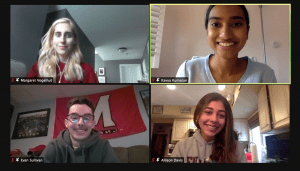#KeepGlobalSmith in BMGT468Z: Creating the Future through Systems Thinking and Design
Having been a student of Dr. Suarez previously at Smith, I was confident that I would learn and grow in completely new ways in his class. Professor Suarez is someone who teaches to inspire and always manages to deliver. I was certain that the class would not be ordinary; that it would challenge me in completely new ways. One of the most exciting components of this class was the intercultural component and it was completely new to my college experience. In BMGT 468Z, we got to actively shape the future with teammates in Barcelona which was amazing! I am incredibly grateful that I had the opportunity to be part of the global classroom.
Without further ado, here are some of my thoughts on the experience:
- Describe your experience in the Global Classroom. What was the best part of your experience? What surprised you about your experience?
The global classroom provided an opportunity to expand my world at a time that we’re all confined to our homes and laptop screens. Connecting with people who were exposed to very different cultural norms and experiences was a constant reminder and that there is always more to learn. The best part of the experience was engaging in a completely different type of learning. Interpersonal learning was key to this class, and the cultural knowledge exchanged through multiple conversations and months of working together was greatly enriching. Additionally, not only did the global classroom allow for immense cultural learning, but it also allowed us to design and problem solve through brainstorming, ideating, and prototyping. I was surprised that it was possible to collaborate and produce a concrete and realistic final product solely through a virtual medium.
- What challenges did you face when interacting and integrating global students in your team and what did you learn from that experience?
The challenges of interacting and integrating global students in my team stemmed mostly from time zone differences and subtle differences in language. Our mentor currently lives in Lithuania, our international teammates live in Barcelona, and my American teammates live on the East Coast. Between our class and work schedules, finding a time to meet consistently could be difficult. In terms of language, my teammates spoke excellent English. However, it would often take longer to communicate certain ideas because our use of spoken English tends to be casual in the U.S, but more formal abroad.
I learned that patience and persistence are crucial to building any team relationship, no matter the culture. It’s important to always assume positive intent and to set clear expectations surrounding team norms. When life gets busy (as it always will!), it helps to have a set day/time to meet, ensuring that your shared project is a priority for all team members.
- What was something that you learned from your participation in this course that you may not have learned otherwise?
This course caused a complete paradigm shift for me. In most courses, coursework is assigned and completed with due diligence. Concepts are learned and then dutifully regurgitated and applied. This course challenged me to think about problem solving in a completely different way because our project was an iterative process. We were constantly revisiting how the healthcare experience is shaped and considering how our project could reimagine this experience. The idea of “problem dissolution”, in which design not only fixes the problem, but causes the problem to become irrelevant, was a completely new concept. However, the most important thing that I learned in this course was empathy driven problem solving and design thinking. Relationship building with our international counterparts was crucial in learning how to use empathy as a tool.
- What has this experience taught you about collaborating with global partners in a virtual environment and designing a solution for a real-life client?
When designing for a real-life client, the stakes are much higher. The possibility that your work could make a real impact on someone’s life is constantly at the forefront of your mind. The challenge is two-fold learning to be innovative, but also feasible. This experience has also taught me that global partners bring a fresh perspective to the table in ways that can completely shift the direction of a project. For example, our international teammates are familiar with the European healthcare system and made me think about accessibility in healthcare in a new light.
- What advice would you give a student considering participating in this type of course?
My advice consists of the 3 K’s:
- Keep an open mind
- (The) Key to everything is consistent communication
- Kindle (and then rekindle!) your enthusiasm
A course in the global classroom will probably be unlike any other class you’ve ever taken. So don’t expect yourself to be experienced and know how to do everything immediately. It might take time for you to adjust to the new format – and that’s ok. If you are struggling, reach out and let other people know – your professor and your teammates. If you want to get to know your teammates better, make an effort and reach out. Consistent communication will build better working relationships. Most of all, don’t forget the incredible opportunity that you have the chance to experience. Reminding yourself of just the exceptionalism of this opportunity will help you redirect your focus and rekindle your enthusiasm every time you get stuck in a rut or struggle to solve a problem.
Thank you to Professor Suarez, Professor Jorge Rodriguez, and our Spain counterparts for bringing this exceptionally unique experience to a Smith classroom! Dr. Suarez leveraged the strangeness of the situation with the pandemic to create something that would not have been possible in an in-person semester – a global experience. I feel honored to have been part of this experience.



